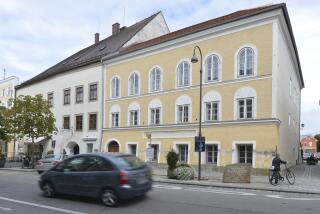Reichstag for the Future
- Share via
While Berlin rebuilds itself as the capital of a united Germany, city leaders face a constant tension between the temptation to eradicate reminders of the infamous Third Reich of Adolf Hitler or to preserve the past so that it will not be forgotten. The past certainly will come to mind when the German parliament moves permanently into the reconstructed Reichstag building during the coming week. But this will be no glorification of the Hitler era.
Hitler and his goons, led by Hermann Goering, made a mockery of the democratic process in the Reichstag at the beginning of the 1930s. And the torching of the building on Feb. 27, 1933 gave Hitler the excuse he needed to seize power through emergency decree.
The neo-Renaissance structure was finished in 1894 as the north and western anchor of Berlin’s government and cultural center that ranged from the nearby Brandenburg Gate eastward along Unter den Linden and Pariser Platz and southward along Wilhelmstrasse, now called Otto-Grotewohl Strasse, to Potsdamer Platz. But the Reichstag became an isolated orphan with the erection of the Berlin Wall beginning in 1961. It stood alone, its east entrance abutting the wall. Many of Berlin’s historic, cultural and religious buildings were locked away in East Berlin.
The Reichstag’s charred remains took more hits during World War II. A first round of reconstruction was completed in 1970, but the elegant dome was not rebuilt until now. The classical bulk of the Reichstag may recall Germany’s imperial past, but the new dome definitely points to the future. It is an airy, open glass structure that serves as a symbol of the new Berlin, open and looking to a prosperous, democratic era to come.
The reconstruction stripped away many false walls that were put up within the building after the war. Laid bare were the scarred old walls that contained grafitti from the end of the war, including anti-German insults scrawled by Soviet soldiers. The British architect who supervised the reconstruction said he was determined that the history of the building not be sanitized.
But other awkward details had to be dealt with. There was even talk for a while of abandoning the name “Reichstag” because it resurrected too many imperial ghosts.
For most of the past century, Berlin has been a center of political and social turmoil, tragedy, ruin and despair--World War I, the Depression, the Hitler dictatorship, culminating in the Holocaust, then 43 years of division and Cold War that often threatened to flare into another world disaster.
One exception stands out: 1923-33, when Berlin flourished as a center of art, film, literature, music, politics, architecture and academics. The Nazis brutally extinguished this, just as they brushed aside their opposition in the Reichstag. Perhaps with reunification and reconstruction, the city can cast aside its guilts and fears, recapture the famed “Berlin luft” and spark a new renaissance of central European life.
More to Read
Sign up for Essential California
The most important California stories and recommendations in your inbox every morning.
You may occasionally receive promotional content from the Los Angeles Times.











